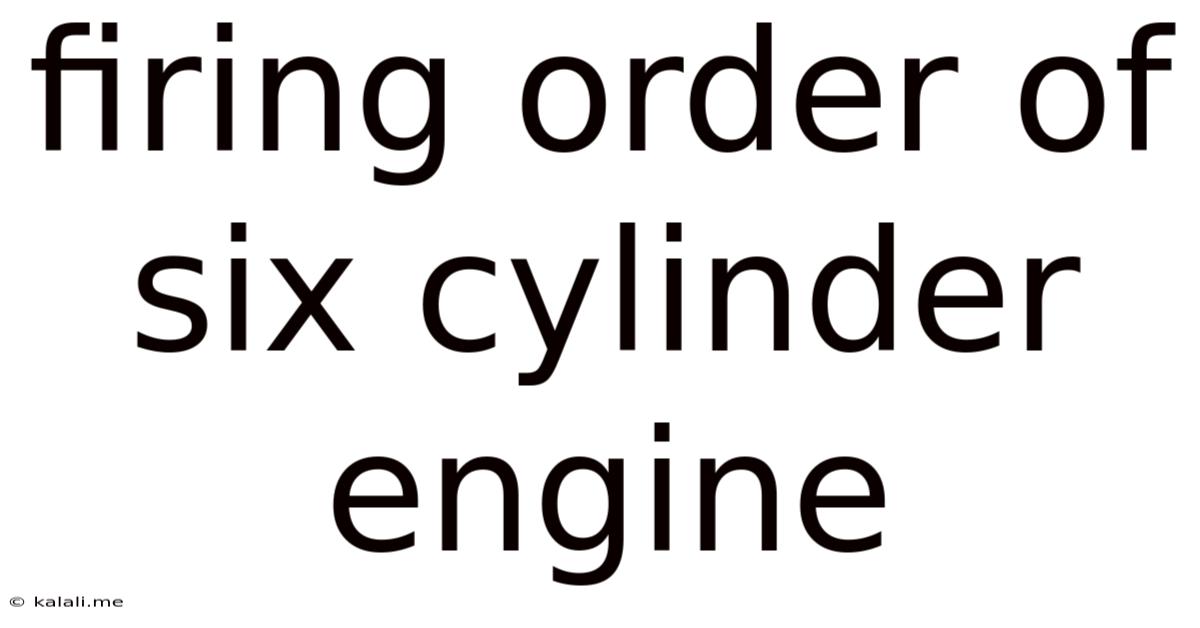Firing Order Of Six Cylinder Engine
Kalali
Jun 11, 2025 · 3 min read

Table of Contents
Decoding the Firing Order: A Comprehensive Guide to Six-Cylinder Engines
Understanding your engine's firing order is crucial for optimal performance and longevity. This article will delve into the intricacies of six-cylinder engine firing orders, explaining what they are, why they matter, and how to identify the correct sequence for your specific engine. This knowledge will be invaluable for anyone working on engine maintenance, tuning, or troubleshooting.
What is a Firing Order?
A firing order defines the sequence in which the cylinders in an internal combustion engine ignite. It's not simply a matter of 1, 2, 3, 4, 5, 6; the order is carefully designed to balance engine forces, minimize vibrations, and optimize power delivery. The firing order is determined by the engine's crankshaft design and the arrangement of the connecting rods. Improper firing can lead to excessive vibrations, reduced power, and even engine damage.
Why is Firing Order Important?
The precise sequencing of cylinder firing is paramount for several reasons:
-
Reduced Vibration: A well-chosen firing order minimizes vibrations throughout the engine. This contributes to a smoother running engine, enhanced driver comfort, and reduced wear and tear on engine components. Unbalanced firing can lead to significant engine shake.
-
Improved Power Delivery: A properly sequenced firing order contributes to more consistent and efficient power delivery. This leads to better acceleration and overall engine performance. A poorly optimized firing order can result in power loss.
-
Engine Longevity: Reduced vibration and smooth power delivery translate directly to a longer engine lifespan. Minimizing stress on engine components prolongs their operational life.
-
Reduced Engine Noise: Even firing intervals reduce engine noise, leading to a quieter and more refined driving experience.
Common Six-Cylinder Firing Orders
While there are variations depending on the engine design (inline-six vs. V6), some common firing orders for six-cylinder engines include:
-
1-5-3-6-2-4: This is a very common firing order for inline-six engines, balancing forces effectively.
-
1-4-2-6-3-5: Another frequently used order, particularly for V6 engines, optimizing power delivery and minimizing vibration.
-
1-6-5-4-3-2: While less common, this firing order is still used in some specific engine designs.
It's crucial to always consult your vehicle's owner's manual or a reliable repair manual to determine the precise firing order for your specific engine. The firing order is often stamped on an engine component or found within the vehicle's documentation.
Identifying Your Engine's Firing Order
If you can't find your engine's firing order in the documentation, some methods you can use to determine it yourself include checking for markings on the engine block, consulting online resources (but always verify with other sources!), or using a specialized engine analyzer tool. However, be cautious when working on your engine, and always prioritize safety.
Conclusion: The Unsung Hero of Engine Performance
The firing order might seem like a small detail, but its impact on engine performance, longevity, and smoothness is substantial. Understanding the firing order for your six-cylinder engine is vital for ensuring optimal engine operation and avoiding potential problems. Always consult your vehicle's manual or a reliable source for the correct firing order for your specific engine model. Remember, working on your engine carries inherent risks; if unsure, seek professional assistance.
Latest Posts
Latest Posts
-
How Many Shots In A Half Gallon
Jul 01, 2025
-
Someone Once Told Me The World Was Macaroni
Jul 01, 2025
-
How Long Does It Take To Walk Five Miles
Jul 01, 2025
-
How Many Ounces Is A Pint Of Blueberries
Jul 01, 2025
-
How Many Dimes Are In 5 Dollars
Jul 01, 2025
Related Post
Thank you for visiting our website which covers about Firing Order Of Six Cylinder Engine . We hope the information provided has been useful to you. Feel free to contact us if you have any questions or need further assistance. See you next time and don't miss to bookmark.